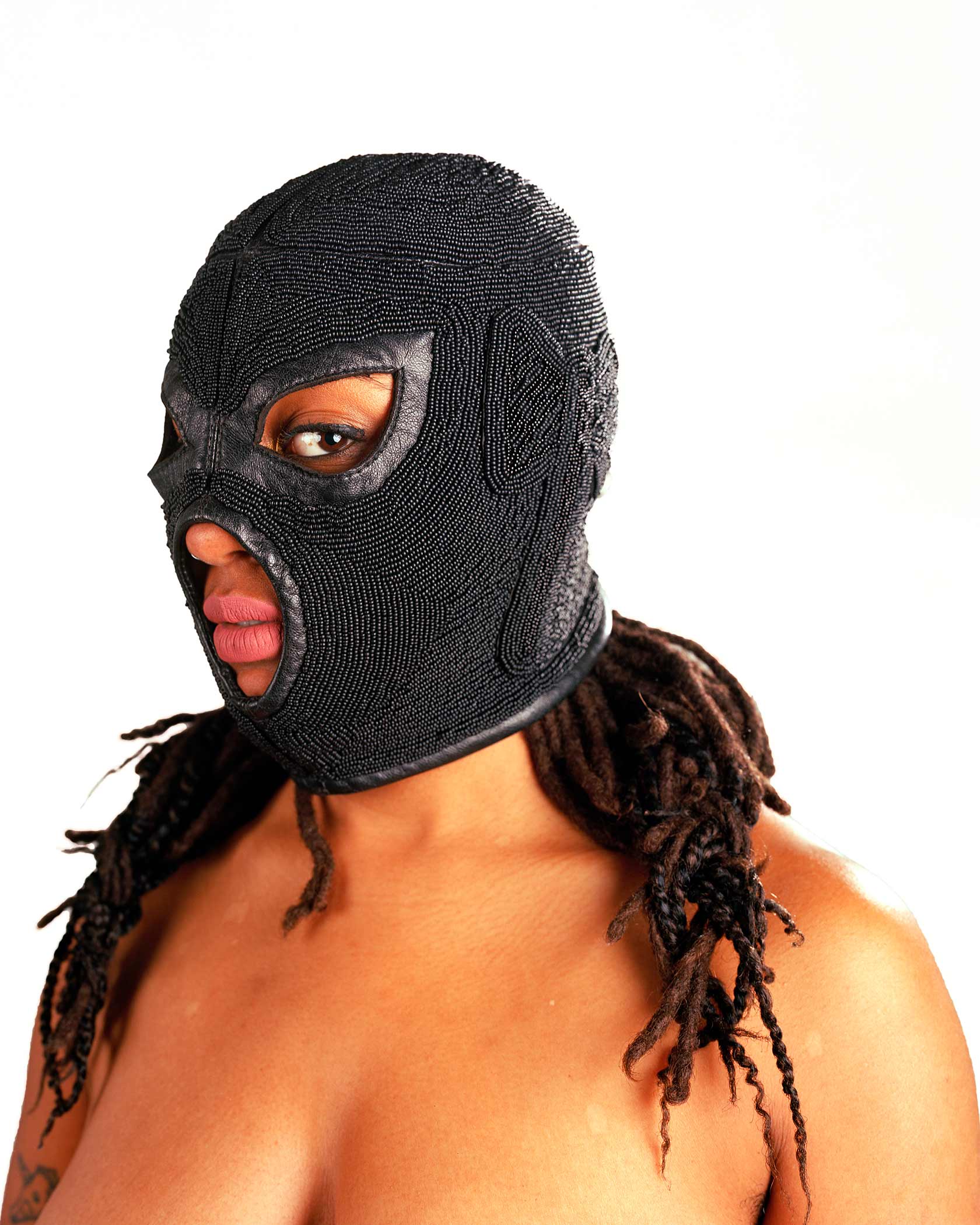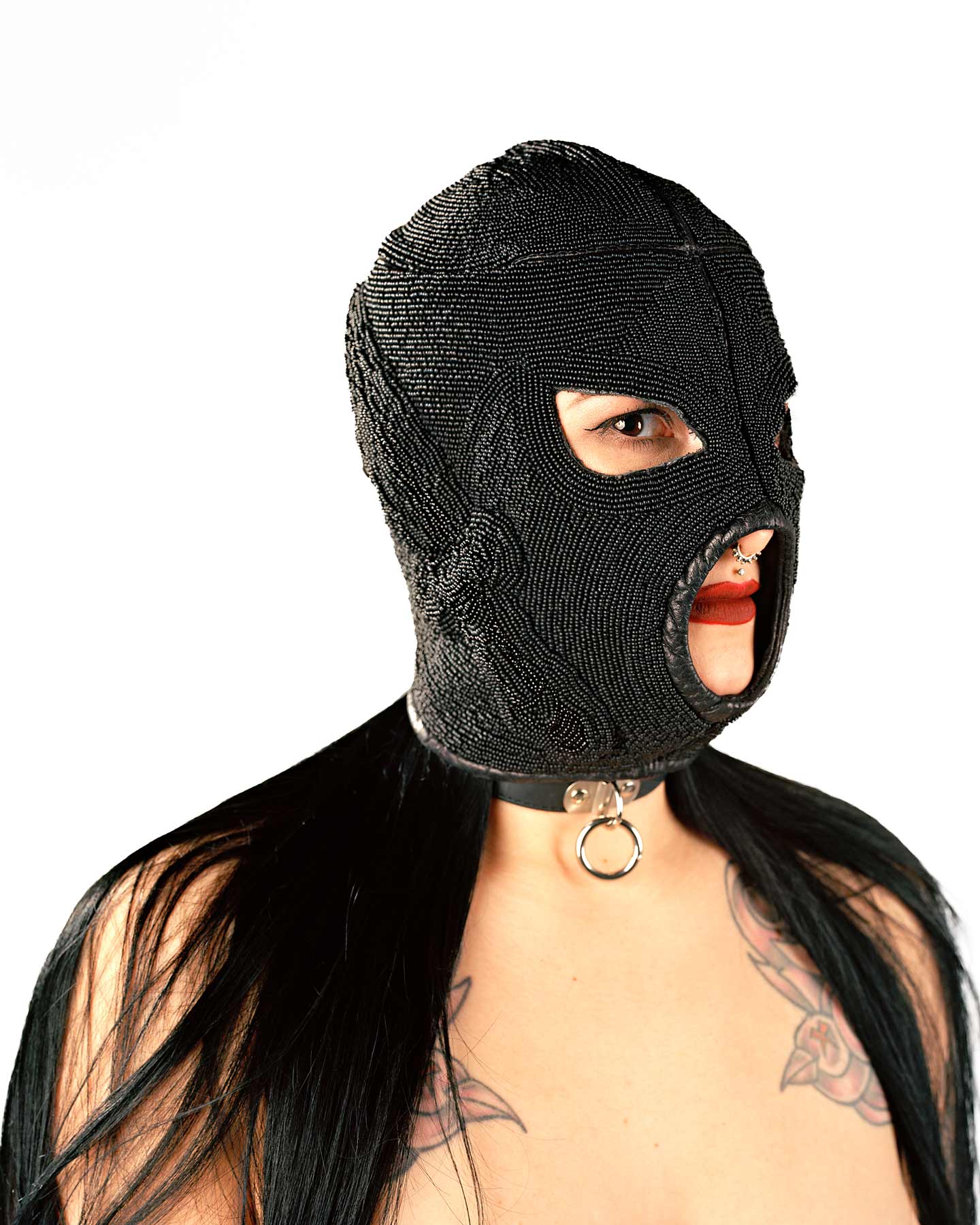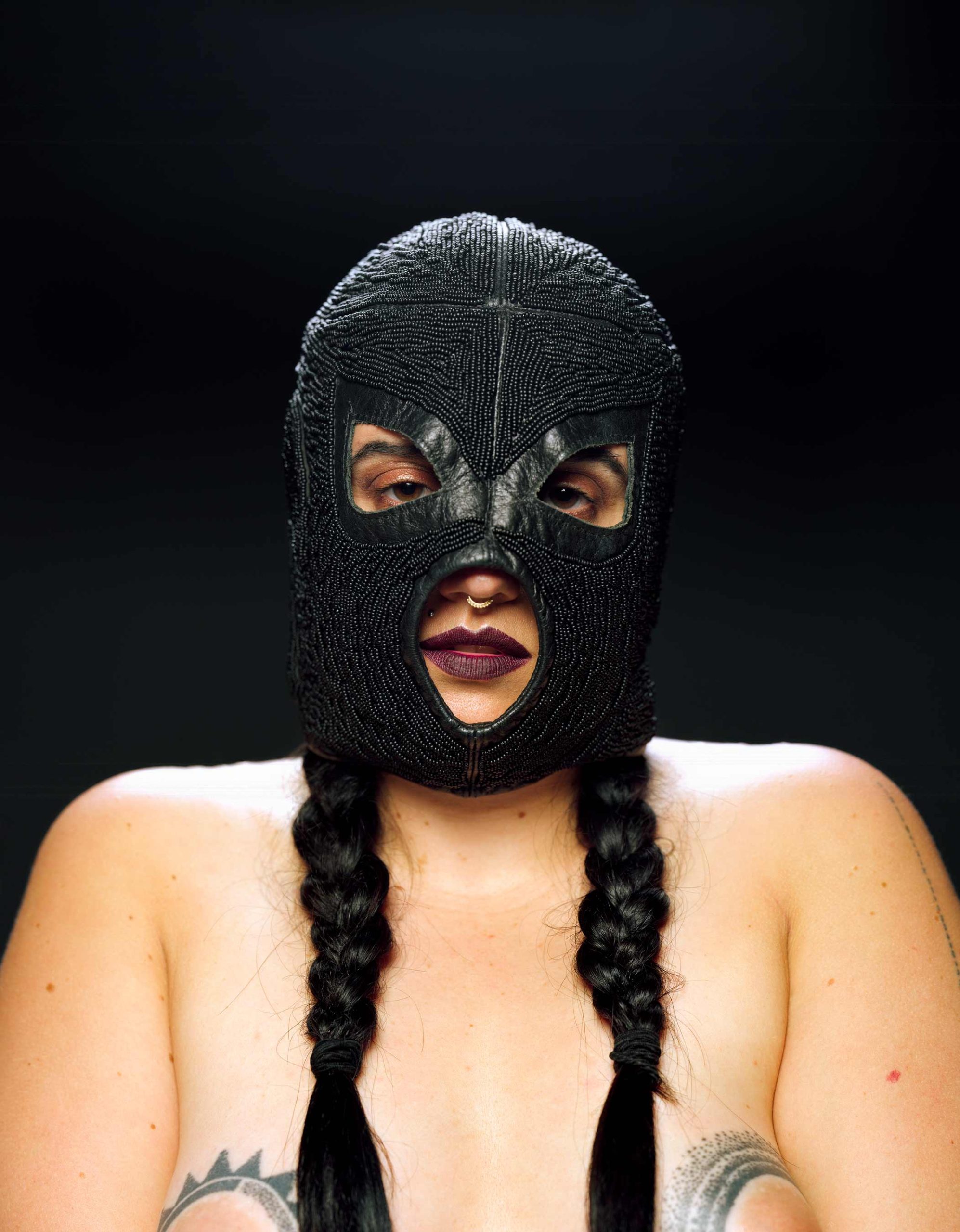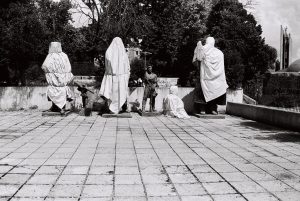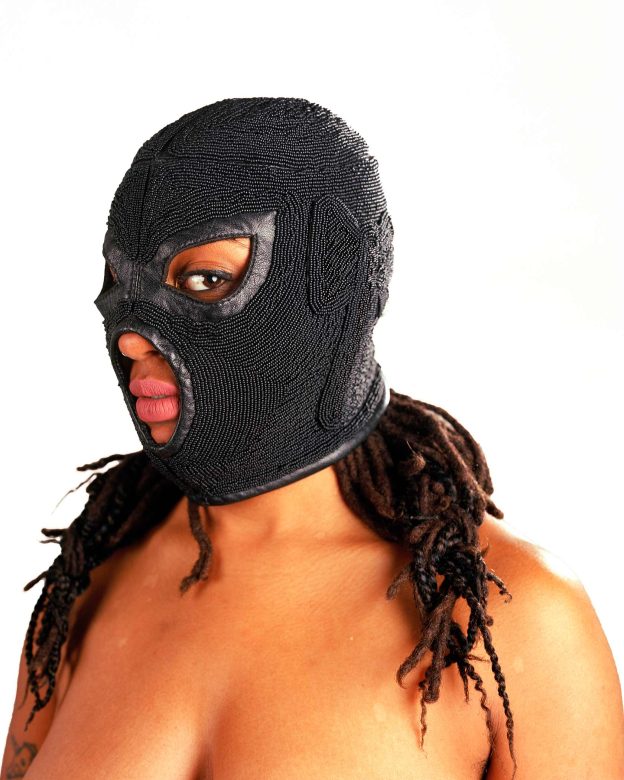
“LIVING MY LIFE”: GRACE JONES PERFORMING THE UNDECIDABILITY OF FEAR AND DESIRE
Word Count: 2,293 |
Download this article
by •
007: DESIRE
with KINSHIP MASKS
photographs by DAYNA DANGER
What does it mean to be undecidable?
Jacques Derrida states that to be undecidable is to be “[in] accordance with what is only ostensibly a paradox, this particular undecidable opens the field of decision or of decidability. It calls for decision in the order of ethical-political responsibility.” This means that those deemed to be “undecidables” are disruptive to the illusion of politics masquerading as ethics or morality, i.e., what is seen as good or bad, safe or dangerous. Yet, being simultaneously neither-nor and either-or problematizes the safety of the binary as a tool for the oppression and marginalization of the other, because the other is also undecidable in the simultaneous fear of and desire for them.
Gray is neither light nor dark but a mix of the two.
Undead is (fictionally) neither dead nor alive but both.
These undecidable subjects fall in between dichotomies, straddling the lines, and disrupting normative binaries that establish privilege; by normative, I am referring to white, cis-heteronormative patriarchial binaries. Normative binaries result in a confusion that combines desire with irrational fear which incites brutality because a supremacist society has no idea what to do with the other. They cannot eradicate the other completely because the other is necessary for the existence of the binary. This means that in binary opposition, the meaning of the privileged side is only defined in comparison to its opposition with the deviant side, meaning that you cannot have one without the other. This space of undecidability and working in between oppositions is where Grace Jones lives as a cultural figure.
Adrienne Dagger
Jones is undecidable with her smooth, dark skin, iconic flat top hair, and towering height. She is neither feminine nor masculine, she is both. Jones reappropriates racialization and gendering simultaneously. She subversively takes on tropes and stereotypes that are commonly associated with black femininity and masculinity. Her combination of aesthetic and performance blends the signifiers of gender binaries that intersect with racial oppression, mixing and exaggerating them to show audiences their absurdity in the most obvious—and sometimes the most understated—but powerful ways.
In her Switch performance of “Living My Life” (1983), Jones takes off her coat to reveal a jacket/corset. It has red and black stripes with exaggerated, armor-like shoulders, paired with black tights or pants and black latex gloves that go up her arms like sleeves. She throws her coat at the camera as the song starts. Three towers of television screens in sets of four stand behind her, displaying multiple images of Jones in real time as she performs. She turns her head and gaze across the audience as the synth melody begins. Her posture is stoic and imposing. Her armored look paired with her height appear as tall as the stacks of televisions. The televisions, in turn, make her seem supernaturally powerful, neither a superhero nor a villain, but a mythical anti-hero, a dark knight, a dark Joan of Arc.
Her stare is low and intimidating, and she frowns as she moves in a stiff-yet-commanding way, never leaving the standing microphone or center stage. The bridge comes, and she tosses her head into profile, posing there for a second with her eyes closed before gracefully moving her head back to center (to the beat), as if emotionally captured by her own song and the feeling it describes, the feeling of being choked for living her life. She knocks her head to the side as she sings “You box me for living my life.” The camera captures her from below, and she looks larger than life. From this angle, it seems absurd that she could sing about someone wanting to box and kill her, when she looks like it would take nothing for her to snuff out anyone. The camera pans out so that you can see her in her entirety, snarling when she says:
Hard as I can
As long as I can
As much as I can
As black as I am
When she sings “You hate me for living. You hate me for living my life,” she sing-talks in a taunting way, snarls, and goes wide-eyed, daring the person or people she’s singing about to come after her now that she is this strong, massive, powerful being. As Francesca Royster states, “in her aggressive and sometimes surreal performance style, [she mocks] any idea that she might not have the upper hand.”
Self Portrait
Stuart Hall defines transcoding as “taking an existing meaning and re-appropriating it for new meanings.” Hall states that black people have been transcoding stereotypes since the 1960s, although I believe we have been deploying transcoding strategies since emancipation, if not before. Furthermore, I see transcoding as not only an effort to fix/change meaning but a very complex way of “carnivalesquing” a representation of one’s identity. That is, transcoding is taking what has been assumed and expected of a marginalized identity by the dominant paradigm and subverting it from within the scene of subjection. As a transcoder, Grace Jones contests the historical subjection of the black female body at the hands of white dominance, especially white male dominance. Jones works from the inside by subverting, disrupting, and deconstructing the historical fantasy/spectacle of negrophilia, that simultaneity of repulsion and arousal, of fear and desire. Her performances evoke the complexities of being both black and a woman, i.e., being considered less than, being exotic, being other, being dominant/emasculating, being sex, being object, and being Venus.
Miriam Kershaw states that Jones has created a “mythical persona” that combines menace, ironic humor, and palpable anger with the pop-postmodernism of the dance scene. These counter-cultural and radically queer-driven aesthetics, performances, and sounds were crucial in the transitional years between the end of disco and the beginning of house music, between the late 1970s and mid-1980s. Kershaw states that, through transcoding, Grace Jones does not “[avoid] the dangerous terrain opened up by the interweaving of ‘race’, gender, and sexuality” and “deliberately [contests] the dominant gendered and sexual definitions of racial difference by working on black sexuality.” Hall speaks of radical black artists like Jones not avoiding the white-patriachal gaze but actively exposing it, subverting it, upending it, and making it so explicitly overt that it is impossible to dismiss its presence and absurdity. Hall continues to state that “instead of refusing the displaced power and danger of ‘fetishism’ . . . [transcoding] attempts to use the desires and ambivalences which tropes of fetishism inevitably awaken.”
Her racial and gender identities will always intersect with how Jones is perceived as other to the dominant social order. Therefore, she disrupts and mimics masculine sexual dominance and wears masculine dress to transcode the black femme as someone who is objecified and simultaneously racialized. Jones is equally reliant on the in-group knowledge or the ancestral gestures and aesthetic of black femme transcoding and black queer performance.
Jones’ aesthetic works outside of what is typically deemed feminine. Her aesthetic is not pretty or ‘real’ by euro-hetero-patriarchal standards. She is not white and softened. She is dark-skinned and angular. She exaggerates her features with makeup, often darkening her skin with an iridescent purple and overemphasizing her bone structure, eyes, and lips to look almost alien. She is not petite, and she makes herself appear unthinkably taller with sky-high heels. She rarely wears wigs because she does not want to make the viewer more comfortable with her as a woman. When she does, the wigs often look cheap and obviously synthetic. I believe she purposefully makes this distinction so that audiences know she is not attempting to look like a “real” (read: white) woman. However, Jones’ femme-ness relies on hyper-sexuality in a way that centers usurption—or, the subordinate’s dominance over the seemingly superordinate—and she uses physical and proxemic dominance, gesture, and tone to do this work.
Kandace Battle Axe
Kershaw states that Jones’ popularity as both a model and artist stem from a historically and socially French obsession with Black Venus figures that manifested in their art and popular culture during modernism. Parisians, particularly, have long obsessed over and hypersexualized black women. In a similar way, Jones’ audience is significantly populated by white cis gay men, and Kershaw argues that they idolize her as a disco diva but also want to embody her specific form of black femme confidence and exotic glamour. Yet they also respond to her performance of masculinity, coding it as their own fantasy of black masculinity. Here, their fantasies, assumptions, and expectations of black male terror, virility, endowment, and dominance are fulfilled, onstage. Royster calls Jones “a site of wonder” as her audience manifests a centuries-old confusion between fear and desire for these men. Jones harnesses this dynamic as a performative dominatrix to expose her audience’s prejudices and expectations of black bodies like hers. By exploiting her audience’s confusion with her performance and aesthetic, she is able to cultivate a cult-like following where white people, men particularly, are desperate to be humiliated by her.
Performatively, Jones twists and mimics in a nuanced and complex way. She deploys a combination of dominance over the superordinate and performance of the other to not just expose the white-patriarchal gaze but also to work through what it means to be other using her difference as an agent for liberation. Her performance of “Living My Life” uses defiant bodily enactment coupled with clever camera work and set design, to convey that she is magnanimous and nearly omnipotent with the numerous television screens showing her face staring directly at you, watching you. She appears godlike and impermeable, as if she cannot be killed nor affected by your desire or your hate of her existence.
Derrida, Jacques. Limited Inc. Translated by Samuel Weber, Northwestern UP, 2008.
Hall, Stuart. Representation: Cultural Representation and Signifying Practices. Sage, 2013.
Jones, Grace. “‘Living My Life’ live on Switch, 1983.” YouTube, uploaded by paul simper, 24 May 2007, https://youtu.be/tLVHHptCmxc.
Kershaw, Miriam. “Postcolonialism and Androgyny: The Performance Art of Grace Jones.” Art Journal, vol. 56, no. 4, 1997, pp. 19-27.
Royster, Francesca T. “‘Feeling like a woman, looking like a man, sounding like a no-no’: Grace Jones and the performance of Strangé in the Post-Soul Moment.” Women & Performance: a journal of feminist theory, vol. 19, no. 1, 2009, pp. 77-94.
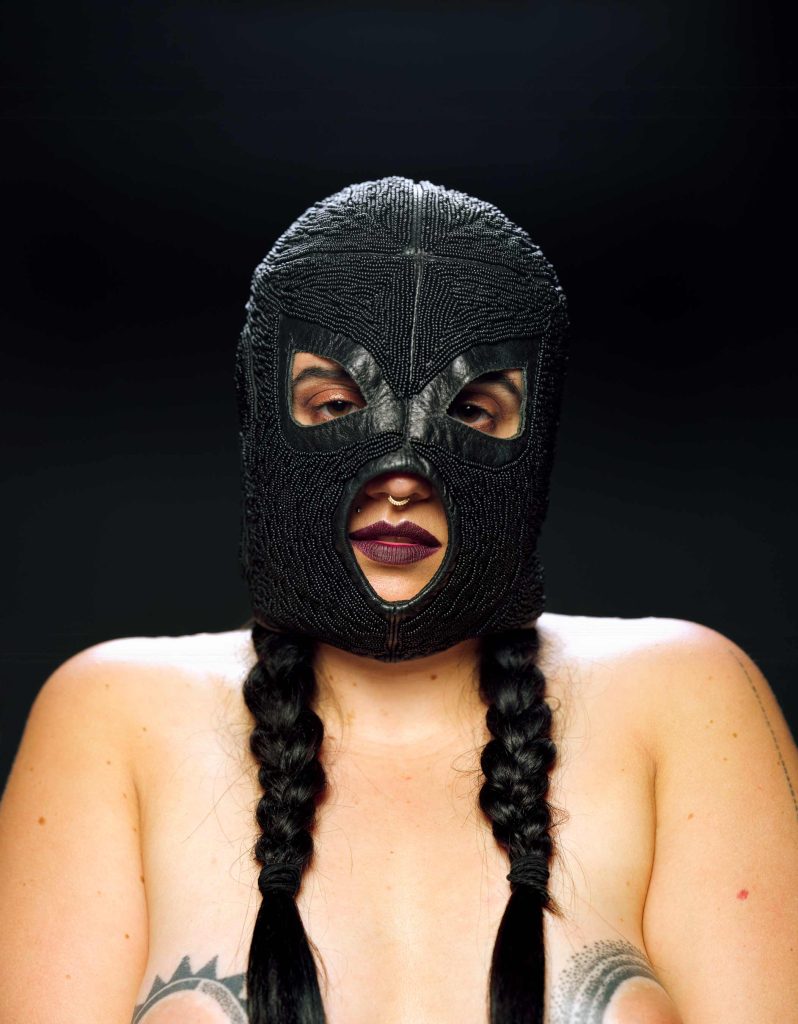
KINSHIP MASKS
“Visual Artist Dayna Danger brings a unique series of photographic portraits that integrate complex black matte and luster beads that are woven into leather BDSM masks, in a series titled Kinship Masks. Each highly-detailed mask incorporates personalized symbols directly linked to the Indigenous individuals represented in the photographs. The intricate chain of time consuming and tedious beadwork was carried out with love by Indigenous relations among Danger’s community namely, Tricia Livingston, Nicole Redstar, Kandace Price, and Rudi Acker. Danger includes Indigenous people with variant gender expressions to create spaces for bodies and identities that have been historically violently erased by settler colonialism. Similar to a BDSM scene, Dayna carefully negotiates each photograph with the highest respect between them and their participants in the studio. These 60 by 75 inch portraits take up as much space as possible to confront the viewer and contradict the identities that are typically viewed, the control that settlers seek over Indigenous bodies, institutionalized sexualities, and reaffirm consensual practices while empowering Indigenous individuals in a kink context. Once the mask and portrait are completed, the finished mask is then gifted to the individual it was made for. It becomes their belonging. Kinship Masks is a continuing artistic and healing process created as an act of resistance and resilience, towards colonial interpretations and language integral to reforging socially visible identities. Much like the entirety of Danger’s practice, this series thrives off of collaboration and community engagement.”
– Day Elijah & Dayna Danger
SEQUOIA BARNES writer
Sequoia Barnes’ work is predominately centered around making processes, rituals, and modes of fashioning. Trained in semiotics, she deploys research through praxis often in her scholarly and artistic explorations of black diasporic symbolisms, storytelling as performance, and positioning the creative process as a performance/ritual.
Her scholarly work currently explores the design techniques and aesthetic semiotics of late fashion designer, Patrick Kelly. Her most recent artistic works include her artist responses to Senga Nengudi (Fruitmarket Gallery) and Nick Cave (Tramway) with performative works entitled Sew Me A Quilt. Tell You A Story. (2019) and The Burden I Bear Is Heavy (2019), respectively.
DAYNA DANGER artist
Dayna Danger is a 2Spirit, Métis-Saulteaux-Polish visual artist and organizer. Danger was raised on the northwest edge of Win-nipi, Treaty 1 territory, or so-called Winnipeg. They are currently based in Tiohtiá:ke (Jo-Jah-Ghey), or so-called Montreal. Utilizing the processes of photography, sculpture, performance, and video, Danger creates works and environments that question the line between empowerment and objectification by claiming space with their larger-than-life works. Ongoing works exploring BDSM and beaded leather fetish masks negotiate the complicated dynamics of sexuality, gender, and refusal in a consensual and feminist manner. Their focus remains on Indigenous and Metis visual and erotic sovereignty. Danger has exhibited their work most recently at the National Gallery of Canada with Àbadakone | Continuous Fire | Feu continuel. They were featured on the cover of Canadian Art’s June 2018 Kinship cover, and they have participated in residencies at the Banff Centre for the Arts and at Plug In Institute of Contemporary Art. Danger is an independent student pursuing an INDI-PhD at Concordia University that focuses on hide-tanning practices from their great-grandmother, Madeline.
© Copyright for all texts published in Stillpoint Magazine are held by the authors thereof, and for all visual artworks by the visual artists thereof, effective from the year of publication. Stillpoint Magazine holds copyright to all additional images, branding, design and supplementary texts across stillpointmag.org as well as in additional social media profiles, digital platforms and print materials. All rights reserved.
